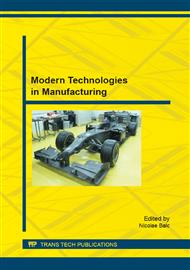[1]
Z. Zhang, C. Breidt, L. Chang, K. Friedrich, Wear of PEEK composites related to their mechanical performances, Trib. Intern. 37 (2004) 271-277.
DOI: 10.1016/j.triboint.2003.09.005
Google Scholar
[2]
J. P. Davim, R. Cardoso, Effect of the reinforcement (carbon or glass fibers) on friction and wear behavior of the PEEK against steel surface at long dry sliding, Wear 266 (2009) 795-799.
DOI: 10.1016/j.wear.2008.11.003
Google Scholar
[3]
H.B. Qiao, Q. Guo, A.G. Tian, G.L. Pan, L.B. Xu, A study on friction and wear characteristics of nanometer Al2O3/PEEK composites under dry sliding condition, Tribol. Intern. 40 (2007) 105-110.
DOI: 10.1016/j.triboint.2006.02.069
Google Scholar
[4]
G. Zhang, A.K. Schlarb, Correlation of the tribological behaviours with mechanical properties of poly-ether-ether-ketones (PEEKs) with different molecular weight and their fiber filled composites, Wear 266 (2009) 337-244.
DOI: 10.1016/j.wear.2008.07.004
Google Scholar
[5]
G. Zhang, A.K. Schlarb, Morphologies of the wear debris of polyetheretherketone produced under dry sliding conditions: correlation with wear mechanism, Wear 266 (2009) 745-752.
DOI: 10.1016/j.wear.2008.08.015
Google Scholar
[6]
W. Z. Nie, J. Li, Effect of carbon fibre content on friction and wear properties of carbon fibre reinforced PA6 composites, Plastics, Rubber and Composites 39 (2010) 10-15.
DOI: 10.1179/174328910x12608851832056
Google Scholar
[7]
Z. Rasheva, G. Zhang, T. Burkhart, A correlation between the tribological and mechanical properties of short carbon fibers reinforced PEEK materials with different fiber orientations. Tribology International 43 (2010) 1430-1437.
DOI: 10.1016/j.triboint.2010.01.020
Google Scholar
[8]
H. Unal, U. Sen, A. Mimaroglu, Abrasive wear behaviour of polymeric materials, Materials & Design 26 (2005) 705-710.
DOI: 10.1016/j.matdes.2004.09.004
Google Scholar
[9]
G. Andrei, D. Dima, L. Andrei, Lightweight magnetic composite for aircraft applications, Journal of Optoelectronics and Advanced Materials 8 (2006) 726-730.
Google Scholar
[10]
L. Chang, Z. Zhang, I. Ye, K. Friedrich, Tribological properties of high temperature resistant polymer composites with fine particles, Tribol. Intern. 40 (2007) 1170-1178.
DOI: 10.1016/j.triboint.2006.12.002
Google Scholar
[11]
G. Zhang, C. Zhang, P. Nardin, W.Y. Li, H. Liao, C. Coddet, Effects of sliding velocity and applied load on the tribological mechanism of amorphous poly-ether-ether-ketone (PEEK), Tribol. Intern. 41 (2008) 79-86.
DOI: 10.1016/j.triboint.2007.05.002
Google Scholar
[12]
G. Zhang, H. Liao, H. Li, C. Mateus, J.M. Bordes, C. Coddet, On dry sliding friction and wear behaviour of PEEK and PEEK/SiC-composite coatings, Wear 260 (2006) 594-600.
DOI: 10.1016/j.wear.2005.03.017
Google Scholar


